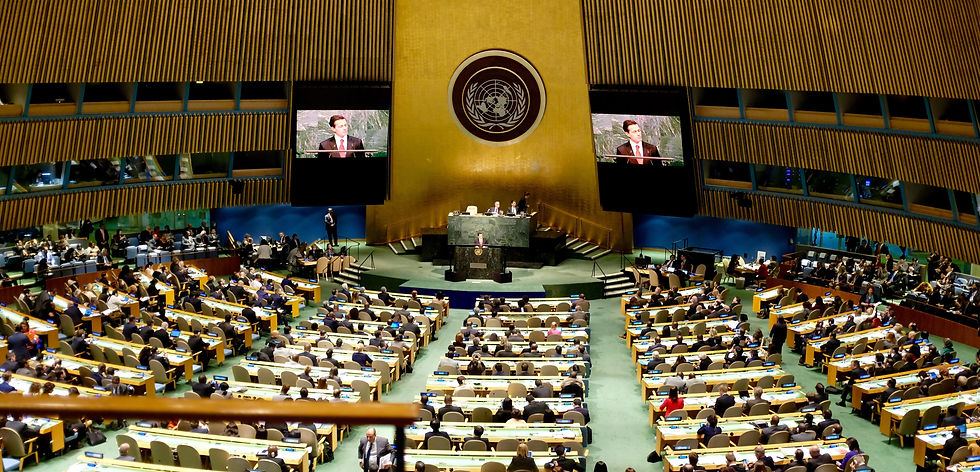The UN, Leading on Climate Change
- sam romano
- Aug 21, 2019
- 4 min read
Updated: Nov 11, 2019

The United Nations provides leadership and a forum for international cooperation to help address climate change and global warming. It is a beacon of hope and we don’t have to look very far for it, because it is us!
The United Nations was founded in 1945. Its membership includes its member nation states (193 at last count), and all the peoples of the world. The United Nations was founded after World War II by the allied victors of the war and its purpose was to prevent future wars, promote development and prosperity for all, especially for people living in extreme poverty and insure human rights.
It was only in 1968 that the UN held its first conference on the environment. A first Earth Summit was held in Stockholm, Sweden in 1972. In 1988 global warming and the depletion of the ozone layer became major concerns, and the Intergovernmental Panel on Climate Change (IPCC), that still is active and prominent today, was established to examine global warming and climate change. All of which led up to a major conference in 1992 held in Rio de Janeiro whose major outcomes produced Agenda 21 ( named for the 21st century), and a forerunner in spirit and content to the current United Nations Sustainable Development Goals and an actual treaty, the United Nations Framework Convention on Climate Change, which under girds all subsequent climate agreements. After Rio, in 1997 the “Kyoto Protocol” was agreed on and aimed at reducing industrialized countries’ overall emission of carbon dioxide and other greenhouse gases. Several conferences and studies later, and taking time to immerse ourselves in Al Gore’s prophetic film “An Inconvenient Truth”, we arrived at the 2015 Paris Agreement on Climate Change. Looking back at its major milestones and achievements, the UN has been officially working on issues related to the environment and climate for over 50 years.
That’s hopeful, but to temper that hopefulness it’s important to reflect for a bit on how the UN works.
It is important to remember the United Nations is a voluntary organization. The UN provides what one might refer to as “global governance”, but not global government. Global governance can occur when a variety of actors (nation-states, the UN and its family of councils and agencies, regional organizations, non-governmental organizations, corporations, academia, unions etc. and just plain folks) come together to try to solve a global problem, i.e. one that transcends national boundaries. The United Nations provides an infrastructure to convene its members and actors, identify a common problem, study and collect data on the shared problem, identify a range of solutions to the problem, raise funds to solve the problem, exhort and inspire collective will to solve the problem, implement solutions to the problem, and, in concert with UN agencies, evaluate and collectively report back on the results. Then start that process all over again. Member states and UN agencies hold themselves accountable in this way.
The 2015 Paris accords essentially do two things: set voluntary goals for nation states to control greenhouse gases and secure funds for a Green Fund which will assist poorer countries in climate change management and mitigation. The bad news is that one country, the United States, has signaled it will pull out of the Paris Agreement, effective on November 4th, 2020. Obviously the current White House is rolling back Obama era climate reforms, opening up new drilling, encouraging new coal plants, relaxing emissions standards etc. Informing the UN of our intent to leave the agreement only underscores what our government has done since 2017.
But the good news is that the remaining 192 member states, including major leadership from China, India and major European states, are committed to remain in the Paris Agreement and reaching their nation’s specific goals of limiting greenhouse gases. And more good news is that several states, cities and other local municipalities as well as corporations in the United States are also committing themselves to the goals espoused in the Paris Agreement. Tony Evers our Governor just announced plans to insure Wisconsin is carbon free by 2050. And the readers of this website (10001 ways to save the environment.com) are certainly doing what they can individually to create a culture to realize the goals of the Paris Accords.
The international community is focusing on sustainable development activities, developing new fossil free energy sources, committing themselves to new land use, planting more trees, notwithstanding the current White House administration and its activities. As we all know, progress against climate change has been halting, and time to make major changes and choices to preserve a livable climate are running out.
For more information on UN inspired progress on limiting climate change and global warming, and to give ourselves a boost of hope, follow developments this fall at the Climate Action Summit to be held at the UN September 23, 2019. Following that Summit, a major climate conference COP26 (Conference of Parties) will be held in Glasgow in June 2020.
All of this momentum of course can only be helped if we get that last piece of the puzzle, the United States government on board. This will only happen if all of us, in the run up to our federal elections on November 3rd, 2020, do what we can to insure there will be a new administration and congress that will rejoin the international community and its United Nations and provide strong leadership from the United States to help manage climate change.
